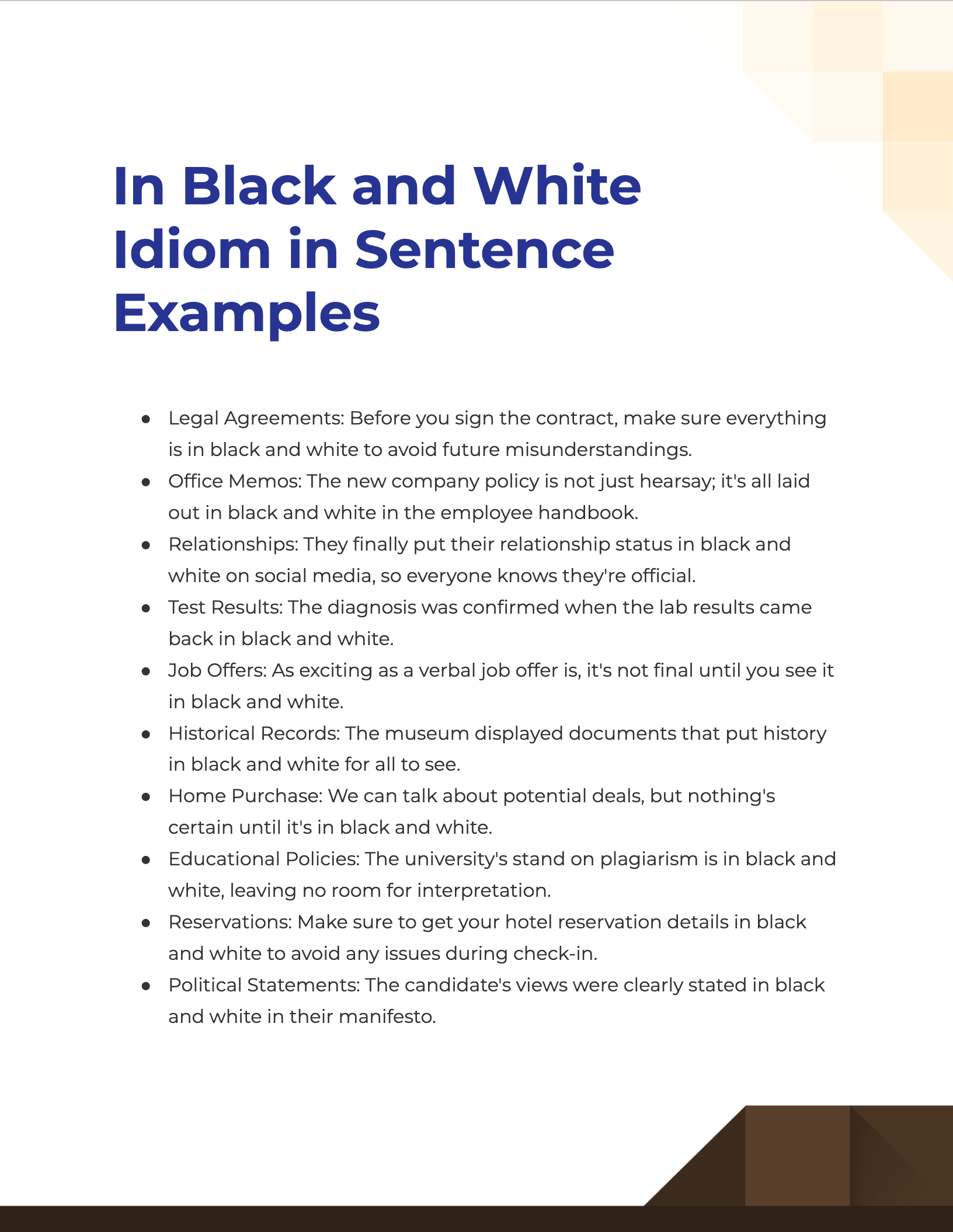19+ In Black and White Idiom Examples
Discover the fascinating world of the idiom “In Black and White” with our comprehensive guide. Uncover its meaning, dive into engaging sentence examples, and master its usage in daily conversations or professional settings. This time-honored phrase has various applications that can enhance your language skills and help you communicate more effectively. Whether you’re a language enthusiast or looking to expand your idiomatic vocabulary, this guide offers a deep dive into one of the most intriguing and widely-used English idioms.
What is In Black and White Idiom? – Definition
The idiom “In Black and White” means that something is clearly stated or written down, leaving no room for confusion or doubt. It refers to situations where facts or agreements are made explicitly clear, usually in written form.
What is the Meaning of In Black and White Idiom?
When something is “In Black and White,” it is presented in a way that is easy to understand and leaves no room for misinterpretation. The idiom often implies that a statement, agreement, or set of facts is documented in writing, be it in a contract, a newspaper, or a formal declaration. The expression encapsulates the notion that writing provides a permanent, unambiguous record. It stresses the importance of clarity and the absence of any grey areas or uncertainty. For example, if two parties have an agreement “in black and white,” this usually means that the terms have been clearly outlined and both parties have acknowledged them, typically through a written document.
Origin of In Black and White Idiom
The idiom “In Black and White” has its roots in the early days of writing and print, where text was typically presented in a clear, easily readable format with black ink on white paper. This contrast not only facilitated reading but also became synonymous with clarity and explicitness. The idea behind the idiom is that when something is written down “in black and white,” it’s formalized and leaves no room for ambiguity or misinterpretation.
The phrase has been part of the English language for several centuries and has been cited in legal documents, literature, and other formal writings where clarity and official record-keeping are paramount. It was especially important in the context of contracts and legal agreements, where putting terms “in black and white” would provide an indisputable record of the parties’ intentions.
Over time, the idiom has broadened to include not just formal or legal documents but any situation where something is clearly stated or defined, be it in writing or spoken language. In modern usage, the term can be applied in various contexts, from business and law to casual conversations, always emphasizing the idea of clarity, directness, and a lack of ambiguity.
20 Unique Sentence Examples Using the Idiom “In Black and White”

- Legal Agreements: Before you sign the contract, make sure everything is in black and white to avoid future misunderstandings.
- Office Memos: The new company policy is not just hearsay; it’s all laid out in black and white in the employee handbook.
- Relationships: They finally put their relationship status in black and white on social media, so everyone knows they’re official.
- Test Results: The diagnosis was confirmed when the lab results came back in black and white.
- Job Offers: As exciting as a verbal job offer is, it’s not final until you see it in black and white.
- Historical Records: The museum displayed documents that put history in black and white for all to see.
- Home Purchase: We can talk about potential deals, but nothing’s certain until it’s in black and white.
- Educational Policies: The university’s stand on plagiarism is in black and white, leaving no room for interpretation.
- Reservations: Make sure to get your hotel reservation details in black and white to avoid any issues during check-in.
- Political Statements: The candidate’s views were clearly stated in black and white in their manifesto.
- Insurance Policies: Your coverage details should be in black and white so you know exactly what’s included and what’s not.
- Meeting Minutes: Everything discussed during the meeting was put in black and white to serve as a formal record.
- Technical Manuals: The safety procedures are in black and white, so there’s no excuse for not following them.
- Restaurant Menus: All the vegan options are highlighted in black and white to make them easily identifiable.
- News Articles: The investigative report laid out the corruption allegations in black and white for all to read.
- Scientific Studies: The research findings were presented in black and white in a peer-reviewed journal.
- Email Correspondence: It’s crucial to get all project specifications in black and white before starting the work.
- Artistic Projects: Before the mural started, the artist presented a sketch in black and white for approval.
- Financial Plans: Your monthly budget should be in black and white to ensure you stick to it.
- Sports Contracts: The athlete wouldn’t commit to the team until all the terms were in black and white.
These sentences show the wide array of contexts where the idiom “in black and white” can be applied. From official documents to casual conversations, this phrase emphasizes the importance of clarity and directness.
More Famous Idioms with Meaning, Sentence Examples
- Play It by Ear Idiom
- Crocodile Tears Idiom
- Full of Beans Idiom
- Busy as a Bee Idiom
- Snake in the Grass Idiom
- Once in a blue moon
- Break a leg Idiom
- Beat around the bush Idiom
- Bite the bullet Idiom
- Through thick and thin Idiom
- Actions speak louder than words Idiom
- Go down in flames Idiom
- Jump on the bandwagon Idiom
- Call it a day Idiom
- It takes two to tango Idiom
- A blessing in disguise Idiom
- Come rain or shine Idiom
- On cloud nine Idiom
- Better late than never Idiom
- Hit the sack Idiom
- Go the extra mile Idiom
- The Whole Nine Yards Idiom
- A penny for your thoughts Idiom
- Pull someone’s leg Idiom
- As right as rain Idiom
- Ignorance is bliss Idiom
- Throw caution to the wind Idiom
- Kick the bucket Idiom
- Take a rain check Idiom
How to Use In Black and White Idiom in Sentences?
The phrase “In Black and White” is a versatile idiom that can add nuance and specificity to your language. Understanding how to incorporate it effectively is key to making your conversations and writings more impactful. Here are some tips on how to use this idiom in sentences:
Understand the Context
Firstly, grasp the situations where this idiom is most relevant. It is primarily used to discuss matters that are clearly defined, often in written form, such as contracts, rules, or official statements.
Choose the Right Sentence Structure
The idiom is quite adaptable and can be integrated into different parts of a sentence. For example:
- As a standalone statement: “The rules are in black and white.”
- Within a complex sentence: “Before you agree to anything, make sure it’s in black and white.”
Using Variations
While the idiom is generally used as-is, you can introduce slight changes without altering its meaning, to fit your sentence better. For instance, “Everything is laid out in black and white.”
Clarity and Emphasis
Use the idiom to emphasize the clarity or unambiguity of the matter at hand. It serves to underscore that something is indisputable because it is clearly documented or stated.
Pair with Other Phrases
You can combine “in black and white” with other idioms or phrases for a richer expression. For example, “The law is in black and white, so there’s no gray area here.”
Tips for Using In Black and White Idiom
Know Your Audience
While the phrase is commonly understood, always consider your audience. If you’re communicating with people who may not be familiar with English idioms, you may need to provide additional clarification.
Don’t Overuse
Although it’s a handy phrase, using it too frequently can diminish its impact. Use it when you want to stress the indisputable nature of something, but don’t overdo it.
Use it in Appropriate Settings
This idiom is versatile but is most powerful in contexts where precision and clarity are valued. These settings include legal discussions, official documentation, and serious conversations where misunderstandings can have significant consequences.
Add Supporting Information
While the idiom itself implies that something is documented or clear, it can be more effective when used with additional information. For example, “The terms were laid out in black and white in Section 3 of the contract.”
Match Your Tone
Ensure that the tone of your sentence or conversation aligns with the idiom’s meaning. If you’re using it to emphasize clarity and factuality, the surrounding content should also reflect this.
By understanding how to use “in black and white” effectively in your sentences, you not only enrich your own language skills but also make your points clearer and more impactful. Whether you’re drafting an official document or explaining something in an informal conversation, this idiom can help you emphasize the clarity and finality of the subject matter.



